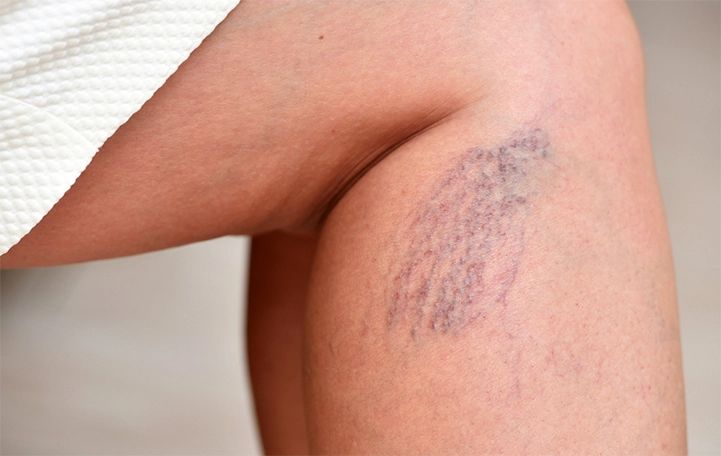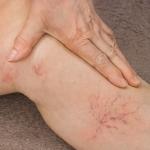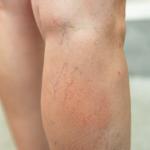
Topics Covered in this Blog:
- What is the Difference Between Spider Veins and Varicose Veins?
- What are the Similarities Between Spider Veins and Varicose Veins?
- Varicose Veins and Spider Veins Treatment
- Schedule a Consultation
Visible veins, such as varicose veins and spider veins, often develop on the legs, ankles, and feet. While there are some key differences between spider veins and varicose veins, they are both signs of underlying vein disease, also known as venous insufficiency.
Below, we discuss the differences between spider veins and varicose veins, along with their similarities, symptoms, and causes. We also provide information on minimally invasive, outpatient vein treatment. Our non-surgical treatments can alleviate venous symptoms, reduce serious health risks, and improve quality of life.
For additional information about varicose veins vs. spider veins, consult a vein specialist.
Sign Up for Our Newsletter to Receive Vein Articles in your Inbox!
What is the Difference Between Spider Veins and Varicose Veins?
The most notable differences between spider veins and varicose veins are their appearance, size, and symptoms.
Varicose veins are swollen, twisted veins that bulge above the skin’s surface. They typically measure 3mm or greater in diameter. Spider veins, on the other hand, are thin, web-like veins that develop just beneath the surface of the skin, typically measuring less than 1mm in diameter. Varicose veins can be blue or purple, most often appearing on the legs, ankles, and feet. Spider veins are more colorful (red, blue, and purple).
About Varicose Veins
Although sometimes thought of as just a cosmetic issue, varicose veins can cause a range of painful and uncomfortable symptoms.
Common varicose veins symptoms include:
- Leg swelling
- Cramping
- Heaviness
- Numbness
- Itching and burning
Individuals with varicose veins may also experience pain relief when their legs are elevated. Venous symptoms tend to be progressive, meaning that they get worse over time.
Varicose veins are a common issue, with approximately 23% of US adults experiencing their effects. When spider veins and reticular veins are also considered, the prevalence increases to 80% of men and 85% of women.
About Spider Veins
Although most often affecting the legs, spider veins can also occur on the hands, face, and other areas of the body.
Not all people with spider veins experience symptoms, but symptoms can occur. Common spider vein symptoms include:
- Swelling in the affected area
- Leg restlessness (especially at night)
- Sensations of tingling, numbness, burning, or itching
- Tenderness or redness surrounding impacted veins
If you experience signs of varicose veins or spider veins, we recommend visiting a vein specialist for medical evaluation.
What are the Similarities Between Spider Veins and Varicose Veins?
Along with the differences between spider veins and varicose veins, there are several similarities. To start, both types of veins are caused by the same underlying condition: vein disease.
Varicose veins and spider veins develop when tiny, one-way vein valves are placed under strain and struggle to carry blood back to the heart. Instead, blood begins to pool, most often in the lower extremities, causing veins to expand. Over time, this condition can lead to venous symptoms, including leg swelling, cramping, itching and fatigue.
Many factors contribute to the development of vein disease, including age, genetics, and lifestyle. Obesity, inactivity, smoking, and prolonged periods of standing or sitting can all raise your risk of having varicose veins and spider veins. Women may also be at increased risk during pregnancy.
Another similarity varicose veins and spider veins share is that both increase your risk for several dangerous health conditions, including blood clots and venous ulcers (open, non-healing wounds). A serious type of blood clot, known as deep vein thrombosis (DVT), can lead to pulmonary embolism, a life-threatening condition. Additionally, venous ulcers can leave you prone to wound and skin infections.
When it comes down to diagnosing varicose veins vs. spider veins, it is important to obtain medical evaluation.
Varicose Veins and Spider Veins Treatment
There are many things that can alleviate symptoms of varicose veins, spider veins, and other venous issues. To get started, we recommend consulting a vein specialist. Our knowledgeable experts can evaluate your symptoms, diagnose the underlying cause, and make personalized treatment recommendations.
If you have varicose veins or spider veins, your specialist may recommend minimally invasive, office-based vein treatment. Although treatment methods can vary between patients, they are designed to provide quick relief from painful symptoms, reduce the risk of developing additional venous issues, and generally improve your quality of life.
Although there are some differences between spider veins and varicose veins, following a healthy lifestyle can benefit both types of problematic veins. Many of our patients see improvement after losing weight, exercising more, eating a healthier diet, and quitting smoking. Additionally, your specialist may recommend wearing compression socks, particularly when standing or sitting for long periods of time.
Schedule a Consultation at USA Vein Clinics
At USA Vein Clinics, our vein specialists are available to further discuss the differences between spider veins and varicose veins. We can also evaluate beneficial lifestyle changes and provide personalized recommendations for minimally invasive, office-based vein treatment.
Our vein treatments can be performed in under an hour, from start to finish. Afterward, you can leave immediately and return to most normal activities. There is no need for general anesthesia, an overnight hospital stay, or a lengthy recovery.
Some of our patients are concerned about the cost of treatment. We want to assure you that most major health insurance plans, including Medicare and Medicaid, cover vein treatment. Our financial specialists would be happy to discuss the details of your plan’s coverage.
We offer over 100 locations nationwide, along with convenient virtual visits. To get started, just schedule an appointment online or give us a call at 888.768.3467.
Medically Reviewed By:
Dr. Yan Katsnelson is a philanthropist, business owner, and highly skilled cardiac surgeon. He is the Founder and CEO of USA Vein Clinics, which is part of USA Clinics Group, the parent company of USA Fibroid Centers, USA Vascular Centers, and USA Oncology Centers with more than 100 facilities nationwide. Dr. Yan has established himself as a strong advocate for accessibility and affordability of the most advanced medical care close to home. His mission is to create a positive experience for each patient with compassionate, personalized, and expert care.






